The Boom and Crash markets are popular among traders for their unique price movement patterns, making them ideal for scalping. This boom and crash scalping strategy focuses on capitalizing on small price movements to accumulate profits quickly.
Understanding Boom and Crash Markets
Boom indices (Boom 500 and Boom 1000) typically feature periodic spikes (booms) in price, while Crash indices (Crash 500 and Crash 1000) often experience sharp drops (crashes). These movements present opportunities for traders to enter and exit positions swiftly, securing profits from these quick price changes.
Boom and Crash are synthetic indices only offered by Deriv and they are available for trading 24/7.
To begin trading using the Boom and Crash scalping strategy, you must first open a synthetic indices account on Deriv. Start by visiting the Deriv website and signing up with your email or social media account, then complete your profile with personal details and verify your identity by uploading the necessary documents.
Once verified, navigate to the Trader's Hub to open a synthetic indices account, set a password for your MT5 account, and transfer funds to it.
After setting up your account, download the Deriv MT5 trading platform, install it, and log in using your synthetic indices account credentials. This process ensures you are ready to trade Boom and Crash indices using the scalping strategy.
You can refer to these step-by-step account opening instructions if you are lost.
Indicators to Use For The Boom & Crash Scalping Strategy
This strategy, which you can use to trade synthetic indices on mt5, needs just two indicators:
- Relative Strength index (RSI) &
- 200 EMA
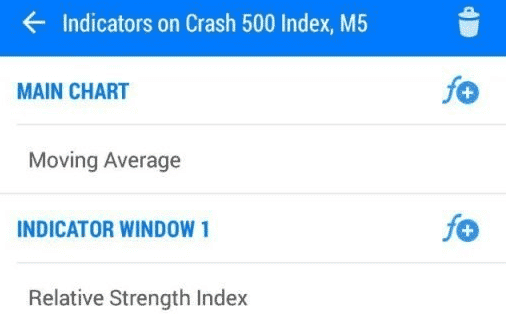
Log in to your DMT5 account and set the following parameters for the RSI.
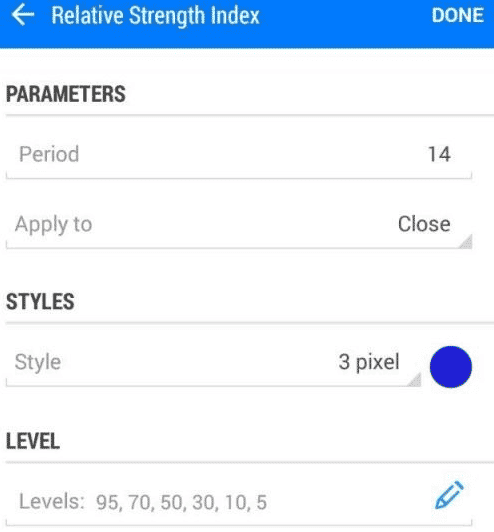
- Period 14
- Apply to close
- Levels 95, 70,50, 30, 10, 5
To set up the EMA simply do the following.
Go to your Indicators, and select moving averages, when the tab opens, you’ll see where it says period, change that to 200, the type of moving average is usually simple by default, select that and change it to exponential.
How To Trade Using the Boom & Crash Scalping Strategy
Key Components of the Strategy
Chart Setup:
- Use the 5-minute (M5) timeframe for precision.
- Employ the Relative Strength Index (RSI) with a setting of 14 to identify overbought and oversold conditions.
- Implement the Moving Average Convergence Divergence (MACD) indicator to confirm trade signals.

Entry Points:
- For Boom indices, look for buy opportunities when the RSI is below 30 (oversold) and the MACD shows a bullish crossover.
- For Crash indices, seek sell opportunities when the RSI is above 70 (overbought) and the MACD shows a bearish crossover.
Exit Points:
- Set a target of 3 to 5 pips for each trade to minimize risk.
- Use a tight stop-loss (2 to 3 pips) to protect your capital in case the market moves against your position.
Trade Execution
Buy Entries For Boom Indices:
- Wait for the RSI to dip below 30, indicating an oversold condition.
- Confirm with the MACD bullish crossover.
- Enter a buy position and aim for a quick profit of 3 to 5 pips.
- Place a stop-loss 2 to 3 pips below your entry point.
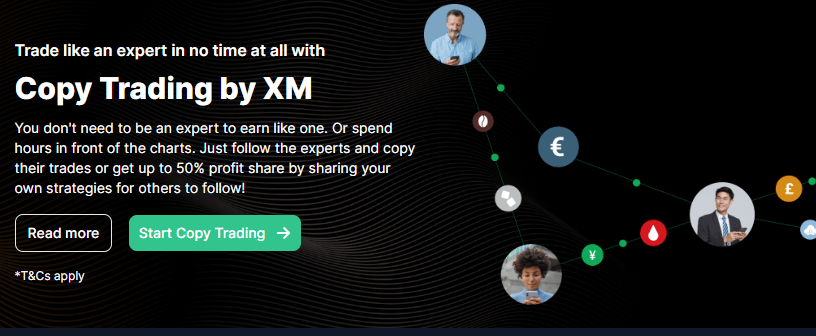
Wait for the RSI to bounce off of the 30 level as shown in the chart below. Once that happens wait for the formation of the third candle and then place a buy trade. Stay in the market for only three pips and then exit.
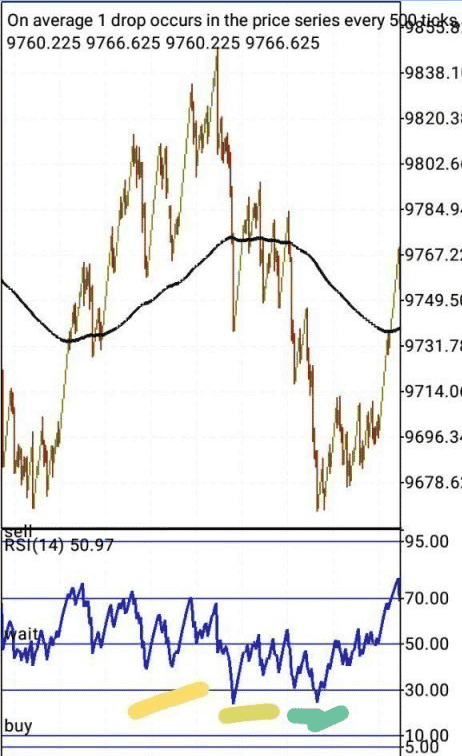
Trading for a small profit target like three pips minimizes market exposure and thus reduces risk. However, to achieve significant profits, especially with the smallest lot size, multiple positions are necessary.
For instance, executing 20 trades with the smallest lot size of 0.20 on Boom and Crash Indices can yield a profit of $14. This approach leverages the quick, small movements in the market while maintaining manageable risk.
Sell Entries For Crash Indices:
- Wait for the RSI to rise above 70, indicating an overbought condition.
- Confirm with the MACD bearish crossover.
- Enter a sell position and aim for a quick profit of 3 to 5 pips.
- Place a stop-loss 2 to 3 pips above your entry point.

Conditions For The Boom & Crash Scalping Strategy
- Your balance should be between $15 – $20 USD or more
- Your profit target should be between $10 – $15 daily
- You need 200 EMA on your main chart and RSI period 14 on your indicator window 1
- Use on the M5 time frame
- Stay in the market for just 3 pips.
The strategy is well-suited for traders with small accounts. See a screenshot showing profits from a small account below.
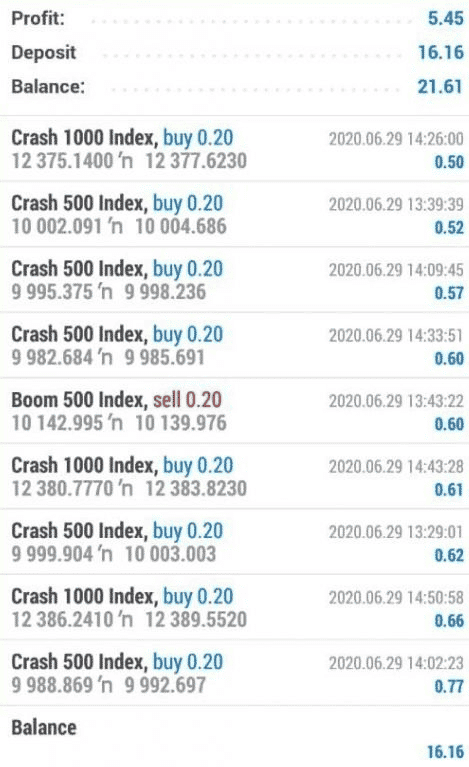
it is advisable to start by practising this strategy on a demo account. You can also try these other strategies for trading synthetic indices
Risk Management
Effective risk management is crucial in scalping due to the high frequency of trades. Always ensure your risk-reward ratio is favorable and never risk more than you can afford to lose on a single trade. Adjust your lot sizes to align with your account balance and risk tolerance.

Tips for Success When Using The Boom & Crash Scalping Strategy
- Practice on demo: Use this strategy extensively on a demo account before using it on a live account to ensure that you fully understand how it works.
- Practice Patience: Wait for clear signals before entering trades.
- Avoid Overtrading: Stick to your strategy and avoid impulsive trades.
- Make sure you have enough equity: Keep in mind the margin requirements for these indices
- Continuous Learning: Keep refining your strategy and learning from your trading experiences.
By following this Boom and Crash scalping strategy, traders can effectively capitalize on the unique characteristics of these indices, achieving consistent profits with disciplined execution and sound risk management.


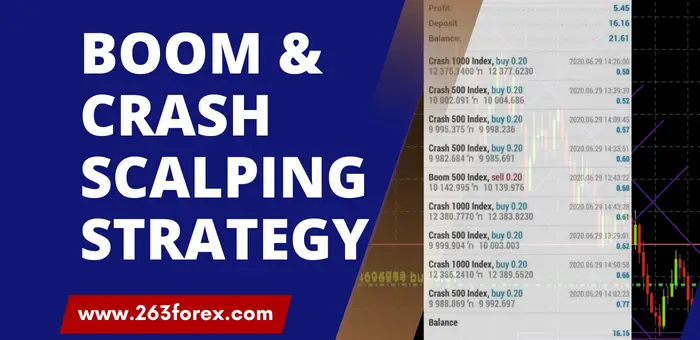

Other Posts You May Be Interested In
Deriv Review 2024: Is Deriv a Trustworthy Broker? 🔍
In my thorough review of Deriv, I found the broker to be highly trustworthy and [...]
Exness Account Types Review 2024 🔍A Comprehensive Guide
In this review, I will share my personal experiences and insights into the various Exness [...]
AvaTrade Review 🔍: Is it the Right Forex Broker for YOU in 2024?
Overall, this Avatrade review found that it can be summarised as a credible and trustworthy regulated [...]
FBS Review 2024 🔍 Is It A Good Broker?
Overall, FBS can be summarised as a reliable broker with a high trust score of [...]
How To Trade XM Thematic Indices
Having spent several months trading with XM thematic indices, I have gained firsthand experience of [...]
Exness Social, Copy Trading Review 2024 📊 Is It Worth It?
Overall, Exness social trading is a good option for traders who are looking for a [...]